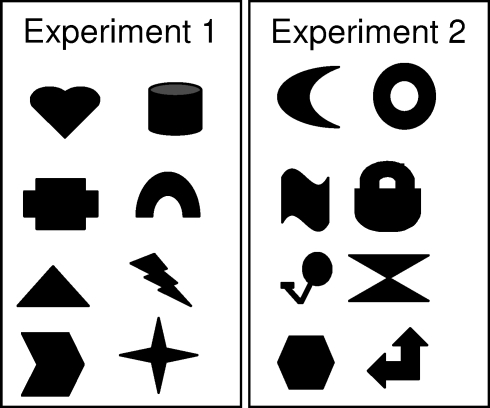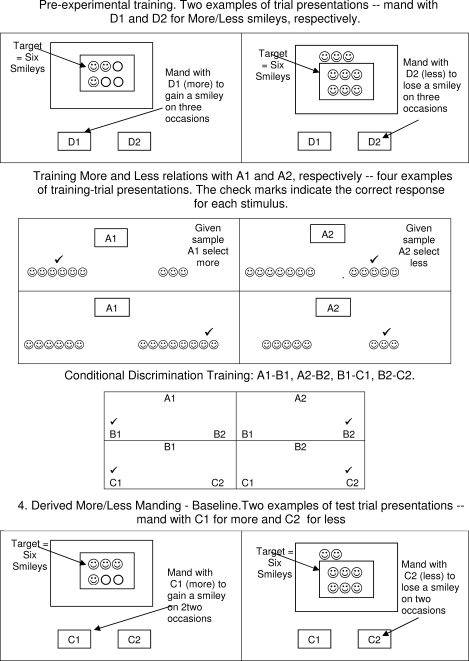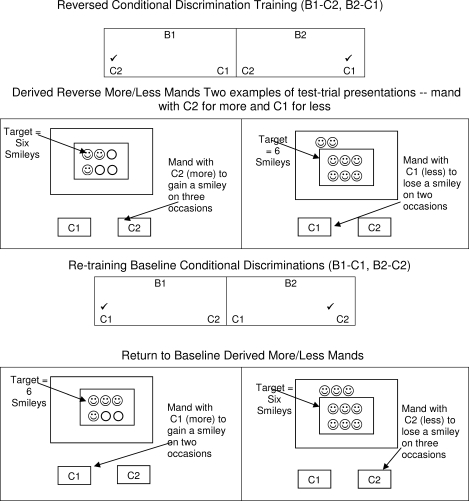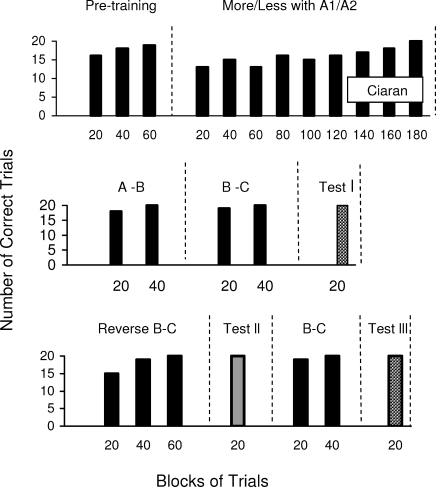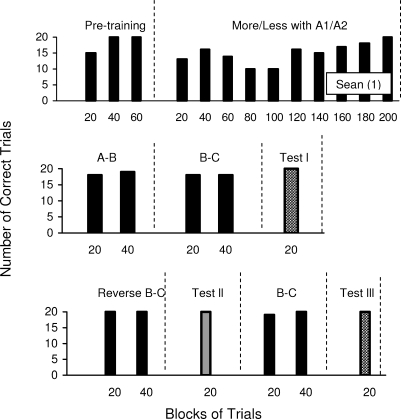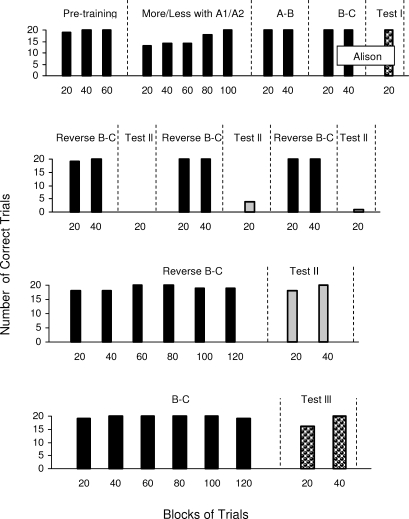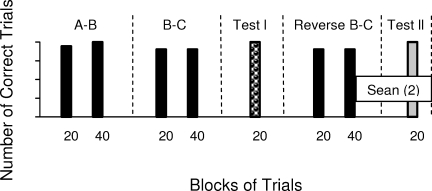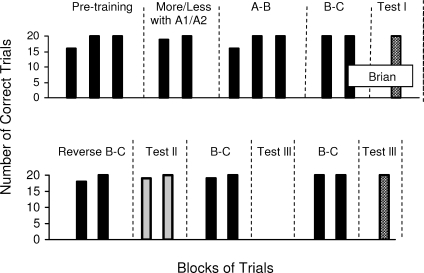Abstract
In Experiment 1, more and less relations were trained for arbitrary Stimuli A1 and A2 with 3 children with autism. The following conditional discriminations were then trained: A1-B1, A2-B2, B1-C1, B2-C2. In subsequent tests, participants showed derived more–less mands (mand with C1 for more and mand with C2 for less). A training procedure reversed the B-C conditional discriminations, and participants then showed derived reversed more–less mands (mand with C1 for less, C2 for more). Baseline B-C relations were retrained, and participants subsequently demonstrated a return to the original derived manding. A second experiment with 1 prior participant and 1 naive participant removed a possible confounding effect. Establishing derived manding may be an advantageous component when teaching a mand repertoire in applied settings.
Keywords: autism, children, derived mands, language, more–less relations
The treatment of learning deficits in children with autism and other developmental difficulties has benefited greatly from interventions and teaching programs derived from applied behavior analysis (Birnbrauer & Leach, 1993; Lerman et al., 2005; Lovaas, 1987; Sundberg & Partington, 1998; Sundberg & Michael, 2001) In Skinner's (1957) account of mands, tacts, intraverbals, autoclitics, and textuals, a mand was defined as an operant response that is under the control of a motivating operation (Michael, 1988) and is commonly termed a request or a command (e.g., “give me some bread,” “stop shouting”). The establishment of a mand repertoire is important for children with language deficits because this verbal skill allows a child to obtain reinforcers or remove aversive stimuli by verbally influencing the behavior of a caregiver (Bijou & Baer, 1965; Braam & Sundberg, 1991; Sundberg, 2004). Although it may be desirable to train particular mands explicitly, an approach that involves directly training every mand that a child may require could be extremely time consuming and labor intensive (Hernandez, Hanley, Ingvarsson, & Tiger, 2007). Ideally, therefore, language-training programs should seek to develop techniques that serve to establish appropriate mand responses in the absence of explicit training.
To examine novel responses, some researchers have suggested that the concept of derived transfer may be useful (Barnes-Holmes, Barnes-Holmes, & Cullinan, 2000; Hayes, Barnes-Holmes, & Roche, 2001; Murphy, Barnes-Holmes, & Barnes-Holmes, 2005). Derived transfer may first involve training a participant in a set of interrelated conditional discriminations in a matching-to-sample context, such that in the presence of Sample A, selecting Comparison B is reinforced, and in the presence of Sample B, selecting Comparison C is reinforced. If a specific behavioral function is then established for A, that function may transfer to the indirectly related C stimulus without explicit training (hence the term derived transfer). For example, a child who learns to mand for two servings of ice cream and then learns that double is another word for two may mand subsequently for double servings without a direct history of reinforcement for doing so.
Derived transfer effects might be used in language-training procedures for children with autism, because such children are frequently said to lack the behavioral flexibility demonstrated in normally developing children (Wahlberg & Jordan, 2001). For example, children with autism often fail to acquire untaught mands based on explicitly trained tact responses (Hall & Sundberg, 1987; Lamarre & Holland, 1985; Nuzzolo-Gomez & Greer, 2004; Petursdottir, Carr, & Michael, 2005; Sigafoos, Reichle, Doss, Hall, & Pettitt, 1990; Sundberg, San Juan, Dawdy, & Arguelles, 1990; Twyman, 1996). Developing procedures that aim to establish derived mands could be important in attempting to produce appropriate novel verbal responses in children with autism and in other language-impaired populations.
For example, Murphy et al. (2005) first trained participants to mand with two stimulus cards (A1 and A2) for two different types of tokens (X1 and X2, respectively). Training procedures subsequently incorporated the two A stimuli in two interrelated sets of conditional discriminations with other stimulus cards (A1-B1, A2-B2, B1-C1, B2-C2). Tests were then conducted to determine if the children would mand with the C stimulus cards (C1 and C2), for the two different tokens (X1 and X2, respectively). In effect, would the mand functions established for the A stimuli transfer to the C stimuli in the absence of explicit reinforcement? Results indicated that the children successfully demonstrated what Murphy et al. described as a derived transfer of mand functions, in which children learned to ask for more using two mand responses that had not been reinforced directly.
The current research sought to increase the complexity of derived manding with children with autism, by attempting to establish two different classes of derived mand: one class functioning as a request for more and the other as a request for less. The current study employed a preexperimental training procedure to teach participants to mand for more or fewer tokens to retain a panel of six tokens in a board game. Experiment 1 then commenced with a match-to-sample procedure that established A1 as functionally equivalent to more and A2 as equivalent toless. The A stimuli were then incorporated into two interrelated sets of conditional discriminations (A1-B1, A2-B2, B1-C1, B2-C2), and tests followed to determine if participants would mand for more and less with C1 and C2, respectively. Training to reverse conditional discriminations was conducted, followed by tests for appropriately reversed derived mands. Finally, baseline conditional discriminations were retrained, and tests followed to probe for the reemergence of the original derived mands. Experiment 2 was identical to Experiment 1 except that derived manding for more or less produced no differential consequences.
GENERAL METHOD
Participants
Three boys and a girl, aged 7 to 11 years, acted as participants across two experiments. All 4 children had diagnoses of autism with the 3 boys described as high functioning. The girl was not described as high functioning and had additional diagnoses of verbal and movement dyspraxia. The children attended a special school for children with autism on a full-time basis (Applied Behavior Analysis Centre for Autism Schooling, Ireland). Each individual diagnosis had been provided by an independent clinical psychologist, with no involvement in the current or related research, in accordance with criteria of the Diagnostic and Statistical Manual of Mental Disorders (American Psychiatric Association, 2000).
Each of the children had been assessed using the Preschool Inventory of Repertoires for Kindergarten (Greer & McCorkle, 2003; Greer, McCorkle, & Twyman, 1996), and each had been categorized under the label “speaker/early reader.” An individual described as a speaker has learned to imitate word topography and to apply appropriately emitted words with acquired mand, tact, autoclitic, and intrverbal functions. Students with an early reading repertoire have begun to learn to read and write simple words. Participants had verbal repertoires that included several hundred tacts, mands, and intraverbals. The girl's verbal repertoire, however, was described by teaching staff as somewhat inflexible (e.g., she was said to lack spontaneous speech). She could mand for a wide range of reinforcers and could tact over 300 items, and she also had a repertoire of approximately 200 intraverbal responses. All 4 children had attended the school for 2 years at the time the study commenced, and all had had approximately 2 years experience with a token economy system employed at the school. In addition, all 4 participants had prior experience with conditional discrimination training with arbitrary stimuli as part of the school curriculum.
Experimental Setting
A desk and two chairs were used in all experimental phases, with the participant seated on one side facing the investigator seated on the opposite side. For all test phases, a third chair was placed to one side of the investigator's chair (out of direct eye contact with the child), and the investigator moved to this chair while a second investigator sat in the first investigator's chair. Various second investigators were drawn from the teaching staff at the school, none of whom were connected with the research or aware of the objectives of the study. Subtle cuing was therefore highly unlikely because the tests were always conducted by the second investigator while the first investigator simply functioned as a second data recorder for the purposes of interobserver agreement.
The 4 participants performed all training and test trials individually, and sessions were usually conducted three or four times per week with each child. Sessions were always interspersed with frequent 2- to 5-min breaks during which participants could engage in a different activity of their choice. The number of sessions required to complete the experiments ranged from 9 to 13 across participants. The duration of sessions was never more than 1 hr, and if a child showed any sign of distress or boredom, sessions were terminated and resumed at a later date.
Interobserver Agreement
For each experiment, correct responses were scored with a plus, and incorrect responses were scored with a minus. Interobserver agreement was calculated by dividing the total number of agreements (defined as two investigators recording a plus or a minus) by the number of agreements plus disagreements (defined as one investigator recording a plus and one recording a minus) and converting this ratio to a percentage. Agreement was calculated for all tests and was 100% across participants.
Materials
All materials were prepared using laminated cards, and color was used to make the stimuli attractive to the children. Each alphanumeric label refers to a specific arbitrary symbol that was clearly printed in red ink on white cards (10 cm by 6 cm). The study employed eight stimulus cards (A1, A2, B1, B2, C1, C2, D1, D2; see Figure 1) for mand training and testing and conditional discrimination training. Twelve yellow circular disks (8 cm) with printed smiley faces were used to establish more and less relations and as a consequence following mands. Mand training and testing involved a colored rectangular board (30 cm by 20 cm) that had a central panel outlined in black with six black circles inside the panel. The second experiment employed a second set of eight arbitrary shapes but the same alphanumeric labels are used to designate the stimuli in both experiments. It is important to note, however, that the second set of stimuli had not been seen before by any of the participants.
Figure 1.
Arbitrary stimuli used for mand training and testing and conditional discriminations in Experiments 1 and 2.
Preexperimental training procedure
At the beginning of the experiment, the investigator paired “winning a game” with praise (e.g., “You've got six smileys, you're winning the game, that's great—well done”). The investigator trained two distinct mand tasks with arbitrary stimuli, and participants learned to mand for more or fewer smiley tokens in order to maintain six smileys on the panel in the center of the board. Participants were trained to mand for more or fewer smileys by presenting one of two different arbitrary stimulus cards, D1 (more) and D2 (less), to the investigator. Arbitrary stimuli are frequently used in studies of derived relational responding to avoid confounding influences due either to physical similarities between the stimuli or to participants' learning histories outside experimental procedures.
The investigator placed the board on the desk in front of the participant, and the D1 and D2 stimuli were placed approximately 12 cm below the board (see top panel of Figure 2). The central panel on the board had six circles, and the participant was instructed that the panel should be filled with no fewer and no more than six smileys. The circles served as visual prompts for absent smileys, and the black outline of the panel served as a prompt to emphasize that smileys present outside the panel were deemed to be surplus (i.e., more than were needed). For each test trial, the investigator placed an amount between three and nine smileys on the board. When amounts were below six smileys, they were placed on circles within the central panel. When amounts were above six, the investigator placed six smileys on the circles and the remainder in the space surrounding the central panel.
Figure 2.
Preexperimental training to mand with D1 and D2 for more or fewer smileys, respectively. Training to establish more or less relations with A1 and A2. Conditional discrimination training A1-B1, A2-B2, B1-C1, B2-C2. Test for derived baseline more–less mands. The checkmarks indicate correct responses.
Figure 2.
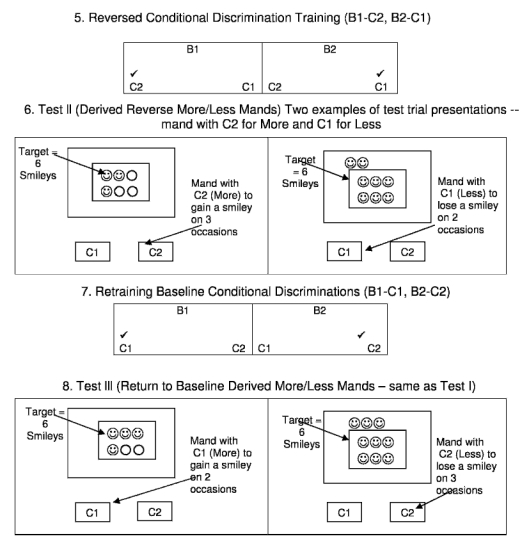
Continued.
If the investigator placed three smileys in the panel, the preexperimental task was to mand with D1 (more) on three consecutive occasions to acquire a total of six smileys (left panel of Figure 2); if the investigator placed nine smileys on the board (six on the panel and three outside), the participant's task was to mand with D2 (less) on three consecutive occasions to reduce the amount of smileys to a total of six (right panel of Figure 2). A trial commenced when the board was presented with greater or fewer than six smileys, and was completed when a participant manded one to three times for more or fewer smileys to make six.
The investigator instructed the participant as follows:
Let's play a game. Count the smileys—you must have six smileys here [pointing to the central panel]. If you have five smileys, give me this card [D1] to gain a smiley. If you have seven smileys, give me this card [D2] to lose a smiley.
When a participant manded correctly by presenting D1 to obtain a smiley when one or more were absent from the center panel or by presenting D2 to lose a smiley when there was a surplus, the investigator delivered or removed a smiley as appropriate. Following correct mands, the investigator also delivered verbal praise (e.g., “that's right,” or “well done”) paired with a token regularly used at the school to access backup reinforcers such as toys, activities, or edible items. These reinforcers were delivered on a variable-ratio 10 schedule, and children were allowed to have a 3- to 4-min break when consuming them.
When a participant manded incorrectly by presenting D1 when there were already six smileys on the board or presenting D2 when there were no surplus smileys, the investigator delivered or removed a smiley according to the card presented, but said, “You should have given me the other card, because you need to gain [lose] a smiley.” The board game was then continued as before.
Trials were conducted in blocks of 20, and the criterion for successful completion of preexperimental training was 18 of 20 correct trials across two successive 20-trial blocks. When participants had successfully completed the preexperimental training procedure, the D1 and D2 stimulus cards were discarded, and the experiment proper began.
EXPERIMENT 1
Method
Training more–less relations with arbitrary stimuli
When participants had successfully completed preexperimental training, they were exposed to training to establish more–less relations with two different arbitrary stimulus cards, A1 and A2. Training more–less relations involved a match-to-sample procedure, and the investigator placed either A1 or A2 approximately 12 cm above two comparison stimuli on the desk in front of the participant (Figure 2, second panel). The comparison stimuli were two separate horizontal rows of smileys, varying from 1 to 12 smileys in each row. The investigator ensured that one row of smileys was always longer than the other (had a greater amount of smileys), and participants learned to select the row with more smileys in the presence of Sample A1 and to select the row with fewer smileys given the Sample A2.
When the sample stimulus was A1 (to be established as functionally equivalent to more), the investigator instructed the participant to “Point to one of these two rows” (indicating the two rows of smileys below A1). If the participant selected the longer row of smileys in the presence of sample A1, the response was followed by immediate verbal praise (e.g., “good, that's right”) paired with a token. If the participant selected the shorter row in the presence of A1, the investigator delivered a correction by gently guiding the child's hand to the longer row, saying “point here,” and no praise or tokens were delivered. If the sample was A2 (to be established as functionally equivalent to less), selecting the shorter row of smileys was followed by praise and a token, and selecting the longer row was followed with a correction and no praise or tokens.
The size of both rows varied across trials so that a row of, for example, five smileys was sometimes more and sometimes less than the other row. Thus, given A1 above and rows of five and three smileys, selecting the former row was correct, but with rows of 5 and 10 smileys, the latter was correct. The student was thus required to respond relationally, in that praise and tokens were contingent on the relation between the comparisons (under arbitrary contextual control) rather than by a particular stimulus amount per se.
Training trials for establishing more–less relations with arbitrary stimuli were presented in blocks of 20, and a block-trial procedure was employed for the first 12 trials in the first block (Smeets, Barnes-Holmes, & Cullinan, 2000; Smeets & Striefel, 1994). Specifically, the amounts of smileys varied, but the shorter row of smileys (less) was always on the left for the first six trials and always on the right for the next six trials. Each of the two samples, A1 and A2, were presented for three consecutive trials (e.g., A1 for Trials 1 through 3 and 7 through 9 and A2 for Trials 4 through 6 and 10 through 12). When the participant selected a comparison and the investigator delivered a consequence, the trial was ended, and the investigator removed the sample and comparisons before recommencing.
During the remaining eight trials of the first block and on subsequent trial blocks, the positional prompt was removed and the left–right position of the comparison stimuli was alternated quasirandomly and counterbalanced across trials. Presentation of Samples A1 and A2 was also quasirandom and counterbalanced, such that each stimulus appeared an equal number of times within each block. The training criterion for more–less relations was a minimum of 18 of 20 correct responses across two successive trial blocks.
Training conditional discriminations with arbitrary stimuli
When participants had completed the training for more–less relations, a second match-to-sample procedure was used to train conditional discriminations that included the A stimuli and four other stimuli (cards with different arbitrary symbols). The trained relations were as follows: A1-B1, A2-B2, B1-C1, B2-C2. Once again, trials were presented in blocks of 20, and participants were required to produce a minimum of 18 of 20 correct responses across two successive trial blocks.
The procedure was conducted in a manner similar to that described for training more–less relations, including the block-trial method, but fixed left–right positions were used only for initial trials (six) for each set of relations (these initial trials were not included in the count of 20-trial blocks). The left–right position of comparison stimuli was randomly rotated on subsequent trials. The two samples were presented quasirandomly, with the constraint that each appeared equally often within each block.
The first set of conditional discriminations involved either Sample A1 or A2 placed above two comparison stimuli, B1 and B2, on the desk in front of the participant (Figure 2, third panel). For the first training trial on each set of conditional discriminations, the investigator instructed the participant to “point here,” indicating B1 if the sample was A1 and B2 if the sample was A2. When a participant selected a comparison on this and subsequent trials, correct selection was followed by praise and a token. Incorrect selection was followed with a correction and no praise or tokens. After the investigator delivered a consequence for the participant's selection response, the trial ended, and the investigator removed the sample and comparisons before recommencing. When participants had completed training in A-B relations, a second set of conditional discriminations was similarly trained. During this training, the B stimuli served as alternative samples above Comparisons C1 and C2, and praise and tokens were delivered for selecting C1 given Sample B1 and C2 given Sample B2.
Test for derived more–less relational mands
When participants had successfully completed the conditional discrimination training procedures, they were presented with a test for derived more–less relational mand functions. The expectation was that the more–less functions trained to A1 and A2 would transfer via the trained conditional discriminations to C1 and C2, respectively. To test this prediction, the board game was used to present a mand context similar to that used in the preexperimental procedure.
For the duration of the test trials, the first investigator moved to a seat at one side of the desk, and the second investigator sat in place of the first investigator. As in the preexperimental training procedure, the investigator placed a rectangular board on the desk in front of the participant, but on this occasion the investigator placed C1 and C2, rather than D1 and D2, approximately 12 cm below the board (see Figure 2, bottom). As before, the investigator placed between three and nine smileys on the board for each trial and informed the participant that the target amount of smileys to be retained in the center panel was no more and no less than six. The operational definition of a test trial was manding to obtain or remove one to three smileys. Thus, each board presentation was counted as one trial, and the number of mand responses for each trial varied randomly from one to three. If a trial involved three mands and a participant manded incorrectly only once, the trial was scored as incorrect. Unlike preexperimental training trials, test trials involved no tokens, verbal praise, or verbal feedback for correct or incorrect responding. The second investigator simply delivered or removed a smiley according to whether the participant manded by presenting C1 or C2. If a participant manded incorrectly, the incorrect delivery or removal of the smiley was followed by termination of the trial. The trial was then scored incorrect, the board was cleared, and the next trial was commenced.
Prior to testing, the investigator instructed the participant as follows:
Let's play a game. Count the smileys—you must have six smileys [pointing to the center panel on the board]. If you have five smileys, give Emma [i.e., the second investigator] a card to gain a smiley. If you have seven smileys, give Emma a card to lose a smiley. See if you know which card you should give each time. We won't tell you if you're right until the end.
The C1 and C2 stimuli had not at any time been directly paired or associated with more or fewer smileys, and participants did not receive prior instruction as to which of the C stimuli was appropriate to mand for more or less. Manding correctly with few, if any, errors demonstrated derived more–less relational mand functions in accordance with the trained conditional discriminations.
All test procedures were conducted in blocks of 20 trials, but to prevent negative effects of inattention resulting from a lack of feedback, each participant was given a break of 5 min after 10 trials. The participant was free to engage in an activity of his or her choice during the break before returning to complete the test. The criterion for passing the test for derived relational manding was 20 of 20 correct trials across one test block or a minimum of 18 of 20 correct trials across two successive test blocks. All tests involved an equal amount of mands for addition and for removal of one token.
Test for derived reverse more–less mand functions
If a child successfully demonstrated derived more–less relational mands (baseline), a reversal procedure was commenced to demonstrate experimental control of derived manding. The prediction was that derived manding would reverse (i.e., mand for more–less with C2 and C1, respectively) as a consequence of training to reverse conditional discriminations and would return to baseline subsequent to retraining in the baseline conditional discriminations. The double reversals thus functioned similarly as a return to baseline in a withdrawal design.
The first reversal involved retraining the second set of the conditional discriminations so that participants now learned B1-C2 and B2-C1 relations (Figure 3, top). The training procedure was conducted as before, except that tokens and praise were delivered for selecting C2 given B1 and for selecting C1 given B2. This was followed by a test for derived reversed more–less relational mands based on the newly trained conditional discriminations (Figure 3, second panel). These test trials were conducted using the board game as before, but on this occasion, the prediction was that children would mand with C1 for fewer smileys and mand with C2 for more smileys.
Figure 3.
Reverse conditional discrimination training B1-C2, B2-C1. Test for derived reverse more–less mands. Retraining of conditional discriminations B1-C1, B2-C2. Test for return to baseline derived more–less mands. The checkmarks indicate correct responses.
Return to baseline, derived more–less mands
If participants demonstrated derived transfer of reversed more–less mands, they were subsequently exposed to the second reversal procedure (Figure 3, third panel). This involved training to reestablish the baseline conditional discriminations (B1-C1 and B2-C2), and this training was followed by a final test procedure (Figure 3, bottom panel). This phase was identical to the test of more–less derived relational mands, and the prediction was that participants would once again mand with C1 for more and mand with C2 for less.
An intervention of massed trials was implemented with 1 participant (Alison) after she failed the test for derived reversed manding. The massed trials intervention required Alison to complete a new training criterion of six consecutive blocks of reversed B-C conditional discriminations with a minimum of 18 of 20 correct responses for each block (these B-C blocks were interspersed with refresher A-B blocks, but these data are not shown because performance was nearly perfect). Because of Alison's difficulties with the first reversal procedure, massed trials were used to retrain the baseline B-C relations. Alison was thus reexposed to six 20-trial blocks of the baseline conditional discriminations (B1-C1 and B2-C2), making a total of 240 massed trials across the two reversal procedures.
Results
Ciaran (Figure 4) required nine 20-trial blocks to establish more–less relations with A1 and A2, respectively (top), and required minimal training (two 20-trial blocks) for both the A-B and B-C conditional discrimination training trials. He successfully demonstrated derived more–less relational mand functions (middle). Minimal retraining was required to reverse baseline B-C conditional discriminations, and when reexposed to the test for derived mands, Ciaran demonstrated derived transfer of reversed more–less mand functions (bottom). He then completed training to reestablish baseline B-C conditional discriminations and subsequently demonstrated a return to the baseline derived more–less mands (bottom panel).
Figure 4.
Number of correct trials for Ciaran during preexperimental training trials to establish manding for more–less with D1 and D2 and more–less relations with A1 and A2 (top); A-B, B-C, and test trials for derived baseline more–less mands with C1 and C2 (second panel); reverse B-C test trials for derived reverse more–less mands with C2 and C1, B-C, and test trials for a return to baseline derived more–less mands with C1 and C2 (bottom).
Sean (Figure 5) required ten 20-trial blocks to establish more–less relations with A1 and A2, respectively (top), but needed only minimal training across all conditional discriminations, including those in reversal procedures. He successfully demonstrated derived more–less relational mands (middle), derived reversed more–less mands (bottom), and a return to baseline derived more–less mands (bottom).
Figure 5.
Number of correct trials for Sean (Experiment 1) during preexperimental training to establish manding for more–less with D1 and D2 and more–less relations with A1 and A2 (top); A-B, B-C, and test trials for derived baseline more–less mands with C1 and C2 (second panel); reverse B-C test trials for derived reverse more–less mands with C2 and C1, B-C, and test trials for a return to baseline derived more–less mands with C1 and C2 (bottom).
Alison (Figure 6) required five 20-trial blocks to establish more–less relations with A1 and A2, respectively, and required minimal training in conditional discriminations. She demonstrated derived more–less relational mands (top), derived reversed more–less mands (third panel), and a return to baseline derived more–less mands (bottom). Note, however, that she initially failed the test procedure for derived reverse more–less mands across three separate exposures.
Figure 6.
Number of correct trials for Alison during preexperimental training to establish manding for more–less with D1 and D2 and more–less relations with A1 and A2 (top); A-B, B-C, and test trials for derived baseline more–less mands with C1 and C2 (second panel); reverse B-C and test trials for derived reverse more–less mands with C2 and C1 (third and fourth panels); B-C and test trials for a return to baseline derived more–less mands with C1 and C2 (bottom).
EXPERIMENT 2
The investigator in Experiment 1 did not deliver verbal feedback or tokens following manding during test trials for derived performances because such feedback is typically removed in studies of derived transfer. Nevertheless, each mand during the transfer test was followed with the specified consequence; that is, a smiley was either delivered or removed by the investigator following the presentation of the C1 and C2 mands. It is possible, therefore, that these contingencies were in part responsible for the test performances observed with the C stimuli. Indeed, a similar criticism could be made of the Murphy et al. (2005) study. On balance, it seems unlikely that the derived manding, at least initially, was produced by differential consequences, because participants frequently demonstrated errorless derived mand performances. Moreover, during the initial (six) test trials, errors occurred for only 1 participant (Alison) and then only during reversal tests.
Nevertheless, Experiment 2 was conducted to eliminate programmed mand consequences as a possible controlling variable in the derived performances demonstrated by participants in Experiment 1 and in Murphy et al. (2005). In Experiment 2, the tests for derived manding were presented in the complete absence of differential consequences. Instead, on each derived mand test trial, the investigator asked the participant, “Which card should you give me this time?” and the participant's response, correct or incorrect, was not followed with the presentation or removal of a smiley. Would derived manding emerge reliably and be maintained under these conditions?
Method
Participants
Experiment 2 was conducted with Sean, who had completed Experiment 1, and Brian, who was experimentally naive.
Materials
The materials used for training and testing were novel, but were similar to those employed in Experiment 1 with the same designated alphanumerics.
Procedure
Experimental procedures were similar to those in Experiment 1 apart from the following details. Prior to test procedures, the investigator instructed participants as follows:
Like before [preexperimental training], you need to have six smileys in here [pointing to the center panel on the board], no more and no less. Count the smileys, then show Emma [second investigator] which card you should give. Emma won't give or take away a smiley, but let's see if you know which card it should be each time. We won't tell you if you're right until later.
As in Experiment 1, during all test trials the board game was presented to participants with three to nine smileys, and the operational definition of a test trial was manding to obtain or remove one to three smileys. Unlike Experiment 1, however, if a participant manded correctly or incorrectly, the entire trial was scored correct or incorrect, and the investigator cleared the board prior to commencing the next trial. Tests involved probes for derived more–less, reverse more–less, and a return to baseline more–less mands, in accordance with the conditional discriminations trained prior to each test.
Results
Sean (Figure 7) demonstrated derived more–less mands and derived reverse more–less mands, in the absence of any differential reinforcement. Sean then became unavailable for further participation. The second participant, Brian (Figure 8), demonstrated derived more–less mands (top), derived reverse more–less mands (top), and a return to baseline derived more–less mands (bottom) in the absence of differential consequences. Brian initially failed the test for a return to baseline derived mands, and was reexposed to retraining in the baseline B-C conditional discriminations. He subsequently demonstrated a return to baseline derived more–less mands.
Figure 7.
Number of correct trials for Sean (Experiment 2) during A-B, B-C, and test trials for derived baseline more–less mands with C1 and C2; reverse B-C and test trials for derived reverse more–less mands with C2 and C1.
Figure 8.
Number of correct trials for Brian during preexperimental training to establish manding for more–less with D1 and D2, more–less relations with A1 and A2; A-B, B-C, and test trials for derived baseline more–less mands with C1 and C2 (top); reverse B-C and test trials for derived reverse more–less mands with C2 and C1, B-C, and test trials for a return to baseline derived more–less mands with C1 and C2 (bottom).
GENERAL DISCUSSION
Across two experiments, 3 boys and a girl (aged 7 to 11 years) with diagnoses of autism demonstrated derived transfer of more–less relational mand functions, derived transfer of reversed more–less mands, and a return to baseline derived more–less mands. In the second experiment, the derived mand performances were obtained in the absence of any differential consequences for mand responses. Consequently, it is highly unlikely that derived manding in Experiment 1 or in the previous study (Murphy et al., 2005) was entirely due to differential consequences for mand responses.
Two participants (Brian and Alison) in the current research initially failed to reverse derived more–less mand performances, but this outcome is generally consistent with previous reversal studies that employed normally developing children and adults. Specifically, studies of equivalence-class formation have shown difficulty in demonstrating reversals, particularly with indirectly related (e.g., C-A relations) as opposed to directly related stimulus pairs (e.g., B-A and C-B; Pilgrim, Chambers, & Galizio, 1995; Pilgrim & Galizio, 1990, 1995; but see Smeets, Dymond, & Barnes-Holmes, 2000). The findings in these studies suggest that the problems with reversals are not limited to individuals with autism. More important, however, the current findings are instructive in that the reversed mand responses were successfully established and reversed again back to baseline following additional training.
A limitation of the current research is that although all tests were conducted by an impartial second investigator, it might be argued that these individuals were not completely naive. For example, Experiment 1 required the second investigator to deliver or remove smileys in accordance with the mand presented, and mands were recorded using plus or minus. It is conceivable that the second investigator could have engaged in subtle cuing of correct responding. Future research on derived mands could avoid this problem by conducting the tests for derived mands in the absence of programmed consequences (as in Experiment 2) and by eliminating the use of plus–minus recording.
The general approach adopted in the current and previous studies of derived mands could in principle be adapted to language training in applied settings. Specifically, teaching procedures could be designed using real-world rather than abstract stimuli, and language-impaired children could be trained and tested for derived mand responses. If such teaching procedures were successful, they could lead to the efficient training of multiple mand responses. Of course, it could be argued that simply training each mand response individually could be equally, if not more, efficient than the more complex and demanding task involved in generating novel mands via derived transfer. Such a strategy, however, would not facilitate the development of derived transfer as a generic response class (see Hayes et al., 2001); thus, eventually this approach may serve to undermine the flexibility and generativity that appear to be such important and defining properties of human verbal behavior.
Given that increased flexibility in mand responding did not occur in the absence of prior conditional discrimination training, derived transfer is clearly implicated; thus, the work is directly relevant to language training in applied settings. Although lower functioning children would not respond as readily to the training procedures described above, it might still be useful to incorporate flexibility into mand training from the outset. For example, rather than teaching a single mand for water to a high criterion before targeting the next mand, it might serve to increase verbal flexibility if water, drink, and juice were taught to criterion simultaneously. Finally, the development of complex mand repertoires may be relevant to adaptive social behavior, in that they may help to prepare children for situations in which mand responses are not consistently reinforced in natural settings.
Acknowledgments
We express our appreciation to the following people for their cooperation and assistance throughout the current research: Marcia Ward provided practical assistance within a research-based school system and Marcia Ward, Neil Kenny, and Emma Farnon functioned as second investigators during experimental procedures.
REFERENCES
- American Psychiatric Association . Diagnostic and statistical manual of mental disorders (4th ed.) Washington, DC: Author; 2000. [Google Scholar]
- Barnes-Holmes D, Barnes-Holmes Y, Cullinan V. Relational frame theory and Skinner's Verbal Behavior: A possible synthesis. The Behavior Analyst. 2000;23:69–84. doi: 10.1007/BF03392000. [DOI] [PMC free article] [PubMed] [Google Scholar]
- Bijou S.W, Baer D.M. Child development II: Universal stage of infancy. Englewood Cliffs, NJ: Prentice Hall; 1965. [Google Scholar]
- Birnbrauer J.S, Leach D.J. The Murdoch early intervention program after 2 years. Behaviour Change. 1993;10:62–74. [Google Scholar]
- Braam S.J, Sundberg M.L. The effects of specific versus non-specific reinforcement on verbal behavior. The Analysis of Verbal Behavior. 1991;9:19–28. doi: 10.1007/BF03392857. [DOI] [PMC free article] [PubMed] [Google Scholar]
- Greer R.D, McCorkle N.P. International curriculum and inventory of repertoires for children from preschool through kindergarten (P.I.R.K.) Yonkers, NY: The Fred S. Keller School and CABAS; 2003. [Google Scholar]
- Greer R.D, McCorkle N.P, Twyman J.S. Preschool inventory of repertoires for kindergarten (P.I.R.K.) Yonkers, NY: The Fred S. Keller School and CABAS; 1996. [Google Scholar]
- Hall G, Sundberg M.L. Teaching mands by manipulating conditioned establishing operations. The Analysis of Verbal Behavior. 1987;5:41–53. doi: 10.1007/BF03392819. [DOI] [PMC free article] [PubMed] [Google Scholar]
- Hayes S.C, Barnes-Holmes D, Roche B, editors. Relational frame theory: A post-Skinnerian account of human language and cognition. New York: Plenum; 2001. [DOI] [PubMed] [Google Scholar]
- Hernandez E, Hanley G.P, Ingvarsson E.T, Tiger J.H. A preliminary evaluation of the emergence of novel mand forms. Journal of Applied Behavior Analysis. 2007;40:137–156. doi: 10.1901/jaba.2007.96-05. [DOI] [PMC free article] [PubMed] [Google Scholar]
- Lamarre J, Holland J. The functional independence of mands and tacts. Journal of the Experimental Analysis of Behavior. 1985;43:5–19. doi: 10.1901/jeab.1985.43-5. [DOI] [PMC free article] [PubMed] [Google Scholar]
- Lerman D.C, Parten M, Addison L.R, Vorndran C.M, Volkert V.M, Kodak T. A methodology for assessing the functions of emerging speech in children with developmental disabilities. Journal of Applied Behavior Analysis. 2005;38:303–316. doi: 10.1901/jaba.2005.106-04. [DOI] [PMC free article] [PubMed] [Google Scholar]
- Lovaas O.I. Behavioral treatment and normal educational and intellectual functioning in young autistic children. Journal of Consulting and Clinical Psychology. 1987;55:3–9. doi: 10.1037//0022-006x.55.1.3. [DOI] [PubMed] [Google Scholar]
- Michael J. Establishing operations and the mand. The Analysis of Verbal Behavior. 1988;6:3–9. doi: 10.1007/BF03392824. [DOI] [PMC free article] [PubMed] [Google Scholar]
- Murphy C, Barnes-Holmes D, Barnes-Holmes Y. Derived manding with seven children diagnosed with autism: Synthesizing Skinner's Verbal Behavior with relational frame theory. Journal of Applied Behavior Analysis. 2005;38:445–462. doi: 10.1901/jaba.2005.97-04. [DOI] [PMC free article] [PubMed] [Google Scholar]
- Nuzzolo-Gomez R, Greer R.D. Emergence of untaught mands or tacts of novel adjective-object pairs as a function of instructional history. The Analysis of Verbal Behavior. 2004;20:63–76. doi: 10.1007/BF03392995. [DOI] [PMC free article] [PubMed] [Google Scholar]
- Petursdottir A.I, Carr J, Michael J. Emergence of mands and tacts of novel objects among preschool children. The Analysis of Verbal Behavior. 2005;21:59–74. doi: 10.1007/BF03393010. [DOI] [PMC free article] [PubMed] [Google Scholar]
- Pilgrim C, Chambers L, Galizio M. Reversal of baseline relations and stimulus equivalence: II. Children. Journal of the Experimental Analysis of Behavior. 1995;63:239–254. doi: 10.1901/jeab.1995.63-239. [DOI] [PMC free article] [PubMed] [Google Scholar]
- Pilgrim C, Galizio M. Relations between baseline contingencies and equivalence probe performances. Journal of the Experimental Analysis of Behavior. 1990;54:213–224. doi: 10.1901/jeab.1990.54-213. [DOI] [PMC free article] [PubMed] [Google Scholar]
- Pilgrim C, Galizio M. Reversal of baseline relations and stimulus equivalence: I. Adults. Journal of the Experimental Analysis of Behavior. 1995;63:225–238. doi: 10.1901/jeab.1995.63-225. [DOI] [PMC free article] [PubMed] [Google Scholar]
- Sigafoos J, Reichle J, Doss S, Hall K, Pettitt L. “Spontaneous” transfer of stimulus control from tact to mand contingencies. Research in Developmental Disabilities. 1990;11:165–176. doi: 10.1016/0891-4222(90)90033-5. [DOI] [PubMed] [Google Scholar]
- Smeets P.M, Barnes-Holmes D, Cullinan V. Establishing equivalence classes with match-to-sample format and simultaneous-discrimination format conditional discrimination tasks. The Psychological Record. 2000;50:721–744. [Google Scholar]
- Smeets P.M, Dymond S, Barnes-Holmes D. Instructions, stimulus equivalence, and stimulus sorting: Effects of sequential testing arrangements and a default option. The Psychological Record. 2000;50:339–354. [Google Scholar]
- Smeets P.M, Striefel S. Matching to complex stimuli under non-reinforced conditions: Errorless transfer from identity to arbitrary matching tasks. The Quarterly Journal of Experimental Psychology. 1994;47B((1)):39–62. [PubMed] [Google Scholar]
- Sundberg M.L. A behavioral analysis of motivation and its relation to mand training. In: Williams L.W, editor. Developmental disabilities: Etiology, assessment, intervention, and integration. Reno, NV: Context Press; 2004. pp. 1–22. [Google Scholar]
- Sundberg M.L, Michael J. The benefits of Skinner's analysis of verbal behavior for children with autism. Behavior Modification. 2001;5:698–724. doi: 10.1177/0145445501255003. [DOI] [PubMed] [Google Scholar]
- Sundberg M.L, Partington J.W. The Assessment of Basic Language and Learning Skills (ABLLS): An assessment, curriculum guide, and skills tracking system for children with autism or other developmental disabilities. Pleasant Hill, CA: Behavior Analysts, Inc; 1998. [Google Scholar]
- Sundberg M.L, San Juan B, Dawdy M, Arguelles M. The acquisition of tacts, mands, and intraverbals by individuals with traumatic brain injury. The Analysis of Verbal Behavior. 1990;8:83–99. doi: 10.1007/BF03392850. [DOI] [PMC free article] [PubMed] [Google Scholar]
- Twyman J. The functional independence of impure mands and tacts of abstract stimulus properties. The Analysis of Verbal Behavior. 1996;13:1–19. [Google Scholar]
- Wahlberg T, Jordan S. A case study in the dynamics of autism. In: Wahlberg T, Obiakor F, Burkhardt S, editors. Autistic spectrum disorders: Educational and clinical interventions. Vol. 14. Oxford, UK: Elsevier; 2001. [Google Scholar]



